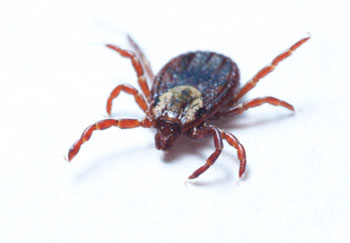
The summer brings longer days, vacation planning, planting gardens, and hiking. It also means dealing with tick-borne illness.
And, compounding the problem, the tick population has been growing. Warmer temperatures, on average, have helped the ticks thrive. While they’re biting year-round, summer is definitely the ticks’ favorite season.
Mail in the Tick
The growth of the tick population plus the rise in tick-borne illness have health officials paying extra attention, too. The Virginia Department of Health is asking people who’ve been bitten by a tick to take a quick online survey, and then mail them the tick. They will use this information to better understand where in Virginia certain tick species can be found, as well as which species are biting people.
Tick-Borne Illnesses
You probably know someone diagnosed with Lyme disease, a bacterial infection that starts with a tick bite. But every year, Virginia residents are diagnosed with two other types of tick-borne illness: Rocky Mountain spotted fever and ehrlichiosis.
“I would definitely say cases of Lyme disease are surging here. And I’ve never used that verb before when it comes to increasing incidence of anything,” says James Nataro, MD, PhD, a pediatric infectious disease expert and physician in chief of UVA Children’s Hospital.
In 2006, Virginia health officials reported 357 cases of Lyme disease to the CDC. In 2016, they reported 976 confirmed cases and another 374 probable cases. And the CDC warns that these numbers don’t reflect every diagnosed case. It estimates that around 300,000 people in the U.S. are diagnosed with Lyme disease every year.
The increase may be due to the bacterium that causes Lyme disease becoming more common in wild mammals and ticks, Nataro explains. And when those wild mammals, like deer, live near humans, the disease spreads easily.
Rocky Mountain spotted fever and ehrlichiosis are not as common as Lyme disease, but UVA Health sees a few cases each year, Nataro says.
Could That “Flu” Be a Tick-Borne Illness?
Lyme disease, ehrlichiosis, and Rocky Mountain spotted fever can have symptoms similar to flu, according to the VDH. Those include:
- Fever
- Fatigue
- Muscle aches
- Headache
“Patients with Lyme do not appear as acutely ill as those with the other two infections,” Nataro says.
Lyme disease and Rocky Mountain spotted fever have characteristic rashes. Lyme’s is a red, irregular circular rash around the tick bite. The Rocky Mountain spotted fever rash begins on the wrists and hands and spreads to the torso over hours to days, Nataro says.
And anyone infected with Rocky Mountain spotted fever or ehrlichiosis is more likely to have a fever and severe headache, he adds.
If you have these symptoms, see a doctor. Deaths from Lyme disease are very rare, but the other two diseases, particularly Rocky Mountain spotted fever, can be life-threatening if not treated, Nataro says.
All three diseases can be treated with antibiotics. In fact, says Nataro, Lyme disease complications can be treated or avoided by taking antibiotics for less than a month. “Prolonged antibiotics are never necessary,” he says.
Tick Bites Can Cause Meat Allergies, Too
Thomas Platts-Mills, MD, who leads UVA’s Division of Allergy and Clinical Immunology, researches the connection between lone star tick bites and red meat allergies. His team found that in some people, a lone star tick bite triggered the body to produce antibodies that binded to alpha-gal, a sugar found in mammals.
For people with alpha-gal syndrome, exposure to alpha-gal results in allergy symptoms. These can be mild, like hives or indigestion, or severe, like anaphylaxis. Alpha-gal is found in all mammalian meat (like pork or beef). Some people with the syndrome were also surprised that gelatin, usually made from mammal bones, could act as a trigger.
Alpha-gal is also present, in smaller amounts, in dairy products. Alpha-gal syndrome leading to dairy intolerance is rarer, but around 10% of those diagnosed with alpha-gal will also react to dairy. So, it’s good to be aware of.
Worried About a Tick Bite?
Make an appointment with a UVA primary care provider.
Avoiding Tick-Borne Illness
Different ticks spread these three diseases. In Virginia:
- Blacklegged ticks, also called deer ticks, spread Lyme disease and ehrlichiosis.
- Lone star ticks and dog ticks spread ehrlichiosis and Rocky Mountain spotted fever. Lone star tick bites can also lead to developing alpha-gal syndrome.
Don’t assume you only need to check your body for ticks after a summertime hike. Ticks can live:
- In wooded areas
- In tall grass
- On your pets, if they’re going outside
And they can turn up even during unseasonably warm days in the winter. Nataro diagnosed a case of Lyme disease in December.
If you’re spending time outside, use insect repellent with DEET and wear a hat. Wearing a long-sleeve shirt and long pants if it’s not too hot will also help keep ticks off you. Put your clothes in the dryer for 20 minutes afterwards to kill any ticks on them.
If you do spot a tick on you or your child, grasp its head with tweezers and pull firmly. And if you have trouble getting it off, see a doctor.


We just moved here to hadensville and have been inundated with ticks…never seen anything quite like it. We live on 7 mostly wooded acres. Is this normal? What can we do. We love it here but it’s this bad now what about the summer
I asked Dr. Nataro, and he says spring and fall are the worst times for ticks. It should actually be better in the summer.
we bought a place in Carroll county VA.near hillsville,it was late fall,early winter,had already been snow on the ground and temps below freezing,when it warmed up during the day it was nothing to find 10 ticks on each of us,i had never seen anything like it,wish i had payed more attention to their color etc.they were not as small as what we call seed ticks but the next size up,little smaller than a match head and voracious.now early summer,we have yet to see one.
I don’t understand why you are not educating people about Alpha Gal allergy which can occur in certain people after a tick or chigger bite. Dr Thomas Platts-Mills, a UVA professor, has published articles linking tick bites and allergic reactions. I have this allergy. It can be life threatening without an epi-pen after consuming mammalian meat. Please promote awareness of this allergy.
Yes, please do sound the warning about alpha gal! I live in central Virginia and have heard of several cases, just in my circle of friends. Many people have not heard of this new tick threat and the consequences of a delayed diagnosis can be life threatening!
Great to see this story! But, given the several peer-reviewed studies, in vivo and in vitro, from top institutions including Johns Hopkins, demonstrating that the Lyme bacteria has a persistent form that is not addressed by current short antibiotic regimes, such a definitive statement about antibiotics seems irresponsible.
I am an admin on the largest Facebook group for people to discuss and find out more about alpha-Gal allergy which is (also called mammalian meat allergy https://www.facebook.com/groups/alphagal/
Over the past two weeks, we have had an unprecedented number of people join the group – we have had over 100 people join! This allergy is very real.
Never before have we had so many people join because they have been diagnosed with alpha-Gal allergy or are supporting a family member who has contracted this allergy to meat and often also to dairy products after being bitten by ticks.
Be careful folks – there is no cure for this life-changing allergy, therefore, preventing tick bites is paramount.
I live in Pulaski VA and was diagnosed with Lyme the beginning of July 2019. My PCP said they have seen a lot of Lyme cases this year. I was put on Doxy for 21 days. The problem is I still have all the symptoms of Lyme. My PCP said that I have PTLDS. Has anyone found a local doctor in the New River Valley that knows more about Lyme??Also, has anyone been tested for co-infections?
My daughter has been ill for most of October; strep, bronchitis, pneumonia and was just diagnosed with Rocky Mountain Spotted Fever. How likely is it, that blood work will show a false positive for RMSF? And, are there doctors in the area (Richmond, VA) that specialize in this disease? Thank you!
I live in Bedford va. I started getting sick in feb. 2018. by june I was about dead from everything know to man. doctors said it was all in my head. after 46 thousand dollars in doctors bills. for every test under the sun,i looked up the master list for lyme,and had just about on the list.It was all the crazy stuff that was on the list that I had that made doctors think I was nuts. I ask to be checked for all tick born diseases. I WAS RIGHT lyme and rocky mountain spotted fever. Im 2years and still fighting this junk. and rocky mount will keep showing back up. 4 times so far.Got the alpha-gal too. It does get better with time. still got a long way to go.
Test accuracy is making Lyme become bigger and bigger every year.. I added your post to our FB group queue: https://www.facebook.com/groups/lymecochronicdisease/
I live outside of Richmond, VA and my husband is an outdoorsman. He has pulled several ticks off of him but none have left a bulls eye mark. However he is experiencing headaches, extreme joint pain, loss of strength in hands, loss of clarity (confusion/fogginess almost like mild dementia, with some vision disturbances – all come and go), nausea, chills and no real fever at this time. We have been to a rheumatology (checked for lymes and found to have one elevated protein (P23)). Therefore was told he did not have Lyme’s. He was sent to rheumatology because one of his inflammation markers was elevated. He has no other health issues. Only other issues is GERD. Is there any physician around the Richmond area that you would suggest? Also this has been going on for approx. 8 months. They have diagnosed him with possible fibromyalgia. He has been tested for auto-immune (lupus, RA, and others all negative). We have seen neurosurgery due to neck pain and he does have degenerative disk but not bad enough for surgery. Prescribed PT some relief, however I do believe this is a separate issue. We are trying to find any assistance with our next step. Not sure if lymes test will pick up the other tick borne illnesses. Any assistance you may provide will be greatly appreciated. As of yesterday our pet was diagnosed with ehrlichiosis. Just a thought on if this could be our next test.